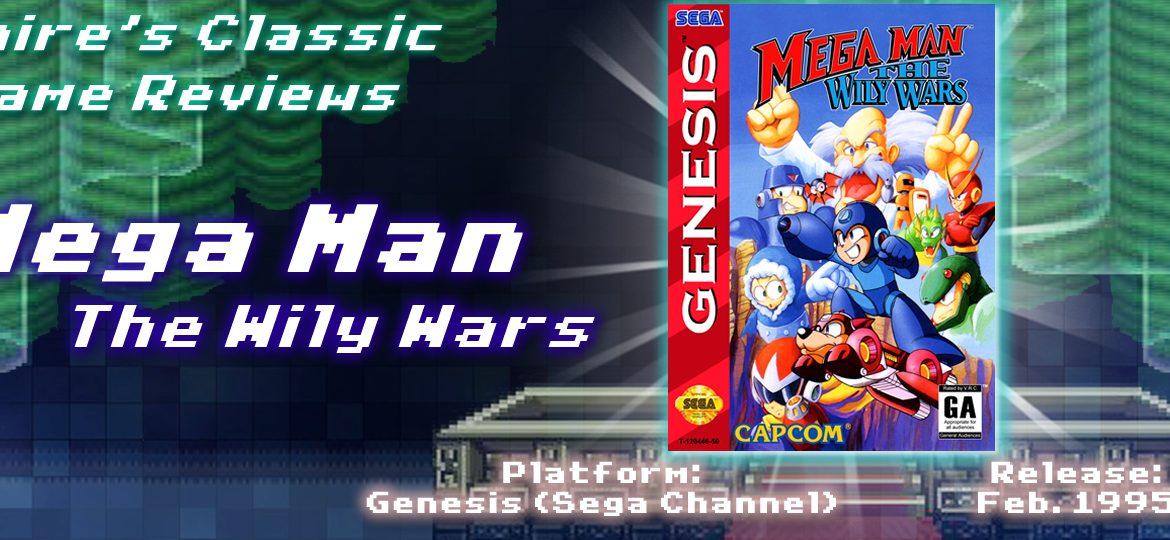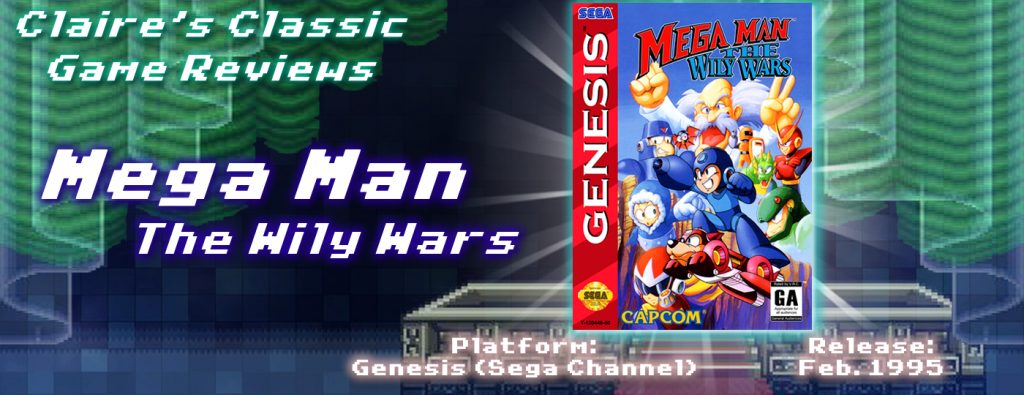This article was originally published on my personal website, thelostmd.com
It was later published on Gamnesia.com
Few people in the States may have heard of Mega Man: The Wily Wars. Wily Wars is a compilation ala Super Mario All-Stars featuring 16-bit upgrades of Mega Man, Mega Man 2, and Mega Man 3, with an unlockable 3-boss game called Wily Tower after you beat the first three games. The reason so few people here may have heard of it is simple: it was only released on Sega Channel, Sega’s short-lived download network for the Genesis. While the rest of the world enjoyed a full retail cartridge release of the game, we were limited access only through a somewhat expensive paid service. But Wily Wars lives on with the likes of importing, reproduction, emulation, and those weird At Games licensed systems. But is it worth it to find yourself a copy? For the true Mega Fan, absolutely. For those of you who aren’t nostalgic for the first three games in the series, it may be a bit hard to jump into.
Rather than review each game on its own merits, I’m mostly going to be discussing the changes this version brings to the table and how they affect gameplay. As all three games are using the same assets and engine, there are a lot of global issues that are different from their NES counterparts. The biggest differences are in how Rock shoots and jumps. His shots are a bit slower and jumping is more precise. The slower shots can make for some added difficulty where it feels like there shouldn’t be. For example, if you are a good enough player to regularly buster-run Mega Man 2, you will struggle with that in Wily Wars and likely have to do an intended boss order to progress. That is, at least until you’ve learned the game mechanics well enough.
Rock no longer has that momentum he has in 1 and 2, and his hitbox is a little strange and takes a bit of getting used to. You can make a jump and be 100% certain you’re going to make it, but if he doesn’t land just right, he’ll slip right off. You can still edge your way off a platform cautiously and be safe with only a few pixels on it, but jumping and landing has a much smaller area of safety. There are also moments where it seems like he’s stuck to a platform a bit; where he won’t jump as high as he should given how you press the button, or won’t jump in time. There seems to be a frame or two difference in jumping on specific platforms, such as 3’s dropping platforms featured on Shadow Man’s stage. Not impossible, but more frustrating that the NES version. It requires a bit of re-learning your muscle memory.
The hitbox issue can pose some problems throughout the rest of the game as well. Because it’s so big, you’re also a bigger target for robot masters. Combining the slower shots with the lack of predictable momentum, ‘sticky’ jumping, and a bigger hitbox, you have a difficulty level a fair bit higher than the NES originals.
The system also has some ups and downs in how it handles certain fights. Some fights, such as the two Yellow Devil battles, and Fire Snakey and Buster Rod G. round two from Wily Tower, have an incredible amount of slowdown. The first Yellow Devil isn’t slowed down much, but enough where you can easily execute your dodging jumps after learning the pattern, and Yellow Devil mk2 slows down so much that it’s made ridiculously easy. What were once moments of control-breaking ragequits for some players are now incredibly easy thanks to the animation lag. However, there is a flipside to this as well.
Other hard bosses such as the Copy Robot in Mega Man are now even harder because they’re better programmed. Copy Rock will stick to you like glue, which makes the previous strategy of manipulating his hit recoil impossible. The other famous strategy for that fight, by shooting and pause-buffering as it goes through the enemy to do multiple hits, is now impossible as that famous glitch is no longer there. Robot masters also tend to move slightly different (some move in entirely new patterns, particularly in Mega Man), which combined with everything else will make old Mega Fans have to re-learn how to beat the bosses.
As you may expect, the Genesis really lends its superior color pallet to these games well. While a lot of enemy sprites are either exactly the same and just re-colored to take advantage of the bigger pallet, the game’s level designs and backgrounds are where the visuals really shine. While some stages look almost exactly the same (a lot of them in Mega Man 2, such as Metal Man’s stage for example), others really got a visual makeover. Most noticeable are the stages from Mega Man, which got a hefty upgrade, and a handful of Mega Man 3‘s stages, particularly the Doc Bot stages. While nothing is as colorful, well-detailed, or visually impressive as any of the Super Nintendo games in the series, they’re certainly an improvement over the NES and a nice little treat for those who are fond of the NES originals.
On the musical side of things, things aren’t so great. Due to the Genesis’ sound capabilities, every tune had to be re-written to play to its strengths and sometimes that doesn’t pull through well. Everything is more bass-y now, with an almost arcade sound to it. If you’ve played the two arcade Mega Man titles, this will sound very familiar. As such, some songs have either been given new life, such as the famous Wily Stage 1 from Mega Man 2, or feel like a bit of a downgrade, like the intro to Mega Man 3. It’s a bit of a mixed bag, and will be sure to disappoint some. Where the old games can be pretty ‘meh’ with sound, Wily Tower shines well. Clearly due to the music being original to the Genesis hardware, the original music for the three Wily Tower robot master levels and then the Wily Fortress stages after really shines through. While one song in particular is way too happy for what you’re doing, and another sounds way too much like Huey Lewis’ ‘I Want A New Drug‘, the original music is wonderful and catchy.
Wily Tower itself is a strange new addition to the Mega Man universe; one only found here in Wily Wars and never seen again. It features three original robot masters based on the Chinese novel Journey to the West: Buster Rod G. based on Sun Wukong, Hyper Storm H. based on Zhu Bajie, and Mega Water S. based on Sha Wujing. After those are cleared, there is a traditional Wily Fortress, with original bosses, leading up to Wily himself. One of which reminds me an awful lot of Barba from Zelda II.
The levels themselves pull enemies from the first three games and provide interesting layouts, sometimes offering an alternate route towards your ultimate goal. Sadly, each of these stages is incredibly easy compared to anything in 1, 2, or 3. This isn’t some mythical ultimate test of your Mega Skills, but rather a fun, if leisurely, stroll that feels like a culmination of everything you went through to unlock it, but with none of the difficulty. I should also mention somewhere that rather than using passwords, Wily Wars features battery-backed saving every time you beat a robot master or get a game over, which is rather nice.
What sets Wily Tower apart from other Mega Man games, aside from the original bosses and music, is the ability to customize your weapon loadout prior to each level, even those in the fortress. You can choose up to eight weapons and three items to take with you on a given level, all pulled from Mega Man 1, 2, and 3. With Rush Coil, Rush Jet, and the Magnet Beam you will be completely set. Want to use the Metal Blades to shoot in eight directions, even against enemies like Snakeys from 3 or those damn Bladers from 1? Go right ahead. However, this does add to the ease of the game. Wily Tower is nice and fun, but way too easy compared to the struggles you have to go through to unlock it.
Overall, Mega Man: The Wily Wars is absolutely worth picking up if you’re a fan of the classic series despite its flaws. If you’re just jumping into the series or casually want to explore the famous early games, I would have to recommend the NES versions. Wily Wars may be a bit of a learning curve for those of us who have those classics burned into our muscle memory, but it’s still a fun ride through to the end and Wily Tower is an interesting, if easy, bit of icing on the 16-bit Mega Cake.
—
Note: I played through Wily Wars on the Retron 5 with system software v0.2.2 update v1.31. This means that the slowdown I experienced may not be present or as bad on real hardware. I also used different controller options: I started with Hyperkin’s own Retron bluetooth controller but found it a tad difficult to get the precision I needed from the 8-way microswitch joystick, so I played the rest of the game using an original NES controller, making it far more comfortable. Using a Genesis controller, the only real issue is the floating d-pad making quick turns and sliding a bit annoying to pull off, and the button layout making it a little harder to jump and shoot at the same time. For anyone considering importing the Japanese or European carts to play on your Retron 5, I recommend using the NES controller.



